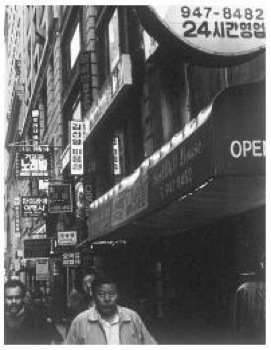Koreatown: Evolution
From Decoding New York
| Introduction |
| Little Italy |
| * Evolution |
| * Here v. There |
| * Economy |
| * What's Real |
| Koreatown |
| * Evolution |
| * Here v. There |
| * Economy |
| * What's Real |
| Comparison |
| * Photo Gallery |
| * Sources
|
The roots of present Koreatown were the few bookstores and restaurants serving the Korean elite in 1970s-1980s. The Korean influence has spread slowly but surely as more Koreans moved to the area due to low rent at that time and convenient location. From the 1990s to present there has been a large influx of Korean immigrants to the United States, which led to the development of Koreatown. Today, Koreatown is packed into just few blocks from 31st to 36th Streets and Fifth and Sixth Avenues. The densest Korean presence is along 32nd Street between Fifth Avenue and Broadway.
Social networks played a huge role in the growth of the neighborhood. Since most of Koreatown was a business area from the start, social networks allowed Koreans to dominate the area without much assimilation in the labor market. The businesses continue to grow and the labor market is constantly replaced by the new influx of Korean immigrants. Many of the businesses continue to thrive because they are largely family-based businesses, and much like Italian shops in Little Italy are inherited from generation to generation. Based on the interviews of the employees in Koreatown, most do not live in Manhattan, but come from Queens, Brooklyn, part of New Jersey. This is to a large extent due to incredibly high rents in the area. However, even though there is not much of residential area in Koreatown, Korean visitors and non-Asian fans of the neighborhood keep this place alive. People come here for a true Korean experience - to enjoy Korean food that is hard to find anywhere else, to shop for authentic high-quality (and pretty expensive) products, and just to enjoy a good Korean company. Asked if Koreatown is a good reflection of Korea, some people said “it’s not the same, but it’s still a better representation of modern Korea than any other Korean neighborhood.” People come from New York City, New Jersey and beyond to have a good time or for some to give them a taste of home. Indeed, it is pretty amazing how quickly Koreatown turned from just a couple of bookstores and a restaurant into one of the most thriving and vibrant ethnic neighborhoods in Manhattan.
